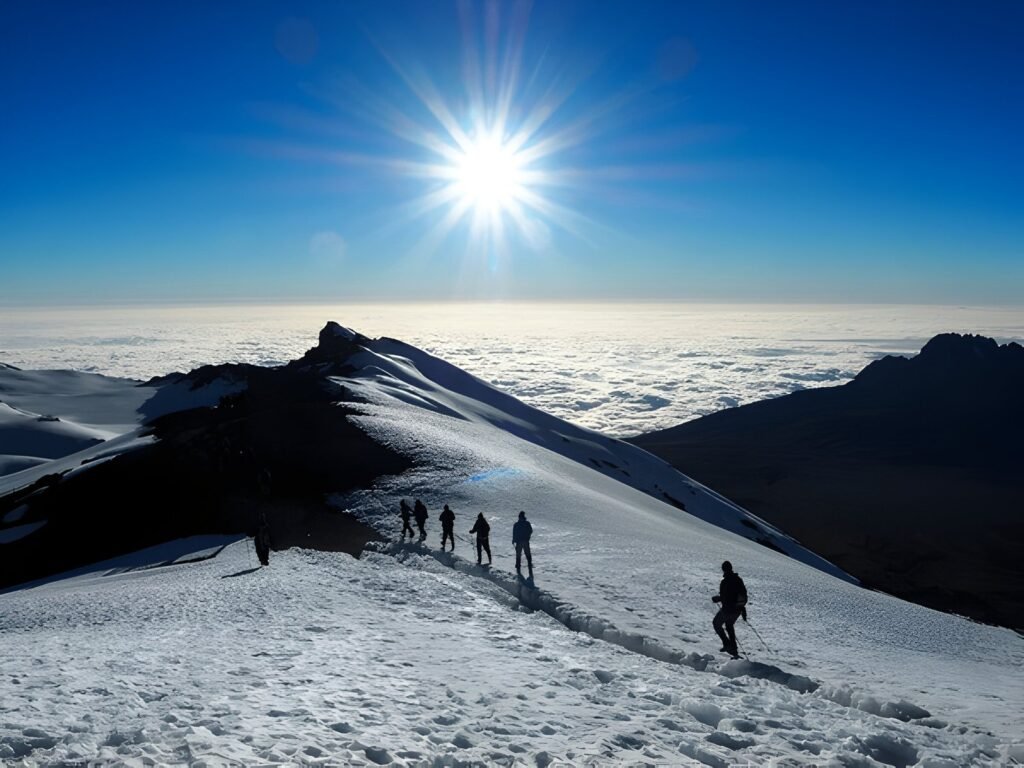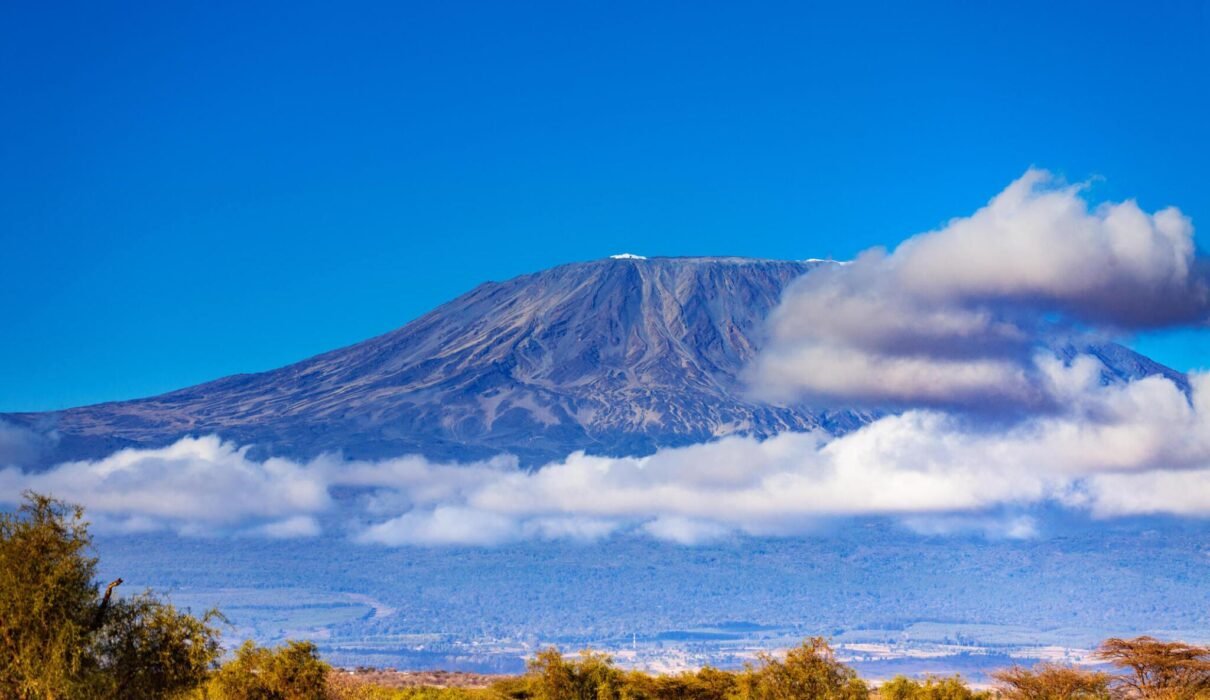Climbing Mount Kilimanjaro-A Complete Guide : Mount Kilimanjaro, standing at 5,895 meters (19,341 feet), is the tallest free-standing mountain in the world and the highest point in Africa. Climbing Kilimanjaro is a dream for many adventurers, offering stunning views, diverse ecosystems, and an unforgettable sense of achievement. Whether you’re an experienced climber or a first-time trekker, there are important things to know before you start your journey to the summit. This guide will cover the key points to help you prepare for a successful climb up Kilimanjaro.

Climbing Mount Kilimanjaro-A Complete Guide : Choosing the Best Route for Your Climb
There are several routes to the summit of Kilimanjaro, each offering different scenery, levels of difficulty, and acclimatization opportunities. Picking the right route is crucial to your success.
Popular Routes:
- Machame Route: Known as the “Whiskey Route,” this is one of the most scenic and popular paths, offering stunning views and good acclimatization. It takes about 6-7 days to complete.
- Marangu Route: Often called the “Coca-Cola Route,” this is the only route with hut accommodations, making it a popular choice for those seeking a less rugged experience. The route takes 5-6 days.
- Lemosho Route: A longer route known for its beautiful, varied landscapes and excellent acclimatization, the Lemosho Route takes 7-8 days.
- Rongai Route: Starting from the northern side of the mountain, the Rongai Route is less crowded and considered easier in terms of terrain but offers fewer acclimatization opportunities.
For more information on the best routes, visit Kilimanjaro Climb Specialist.
Explore more about Kilimanjaro’s routes.
Climbing Mount Kilimanjaro-A Complete Guide : How Long Does It Take to Climb Kilimanjaro?
The duration of your climb depends on the route you choose and your level of fitness. Most routes take between 5 and 9 days. However, the longer you spend on the mountain, the better your body can acclimatize to the altitude, which improves your chances of reaching the summit successfully.
Longer routes like Lemosho and Northern Circuit are recommended for better acclimatization, while shorter routes like Marangu are more challenging due to less time to adjust to the altitude.
Learn about the importance of acclimatization.
Climbing Mount Kilimanjaro-A Complete Guide : Training and Preparation for Kilimanjaro
Climbing Kilimanjaro does not require technical mountaineering skills, but it does require good physical fitness. You’ll be trekking for long hours each day, often in challenging conditions.
Key Training Tips:
- Cardiovascular Endurance: Build up your stamina by doing regular cardio workouts like hiking, running, cycling, or swimming.
- Strength Training: Focus on strengthening your legs and core with exercises like squats, lunges, and planks.
- Practice Hikes: Go on long hikes with a loaded backpack to simulate the actual trek. Gradually increase the difficulty and elevation of your hikes.
- Acclimatization: If possible, practice hiking at higher altitudes before your Kilimanjaro climb.
Read more about training for high-altitude trekking.
Climbing Mount Kilimanjaro-A Complete Guide : What to Pack for Your Kilimanjaro Climb
Packing the right gear is essential for a successful Kilimanjaro climb. Tanzania’s weather can change quickly, especially at high altitudes, so it’s crucial to be prepared for all conditions.
Packing Essentials:
- Layered Clothing: Bring moisture-wicking base layers, insulated jackets, and waterproof outer layers.
- Trekking Boots: Comfortable, broken-in boots with good ankle support are a must.
- Sleeping Bag: A four-season sleeping bag rated for sub-zero temperatures is essential.
- Headlamp: For summit night, when you start your final ascent in the dark.
- Trekking Poles: Help reduce the impact on your knees and provide stability on uneven terrain.
- Hydration System: Carry a water bladder or bottles to stay hydrated throughout the day.
For more details on what to pack, check out this Kilimanjaro packing list guide.
Climbing Mount Kilimanjaro-A Complete Guide : Understanding Kilimanjaro’s Weather and Climate
Kilimanjaro’s weather varies dramatically as you move from one altitude zone to another. You will experience everything from tropical conditions at the base to freezing temperatures near the summit.
- Base (Rainforest Zone): Warm and humid.
- Heath and Moorland Zone: Cool and less humid.
- Alpine Desert Zone: Dry, windy, and cold.
- Summit (Arctic Zone): Extremely cold, with sub-zero temperatures and strong winds.
The best times to climb Kilimanjaro are during the dry seasons from January to mid-March and June to October, as these months offer the most stable weather conditions.
Explore more about Kilimanjaro’s climate.
Climbing Mount Kilimanjaro-A Complete Guide : Dealing with Altitude Sickness
Altitude sickness is one of the biggest challenges when climbing Kilimanjaro. As you ascend, the air becomes thinner, and your body has to work harder to adjust. Symptoms can include headaches, dizziness, shortness of breath, and nausea.
Tips to Minimize Altitude Sickness:
- Climb Slowly: “Pole, pole” (slowly, slowly) is the mantra on Kilimanjaro. A slow pace helps your body acclimatize.
- Stay Hydrated: Drink at least 3-4 liters of water per day.
- Take Acclimatization Days: Choose a route with acclimatization days built in.
- Consider Medication: Some climbers take Diamox (acetazolamide) to help prevent altitude sickness.
For more information on altitude sickness, check out this guide to altitude illness prevention.
Climbing Mount Kilimanjaro-A Complete Guide : What to Expect on Summit Day
Summit day is the most challenging part of the Kilimanjaro trek. You’ll wake up around midnight to begin your ascent to Uhuru Peak in the dark. The climb is steep, and the altitude can make every step feel difficult, but reaching the summit at sunrise is an unforgettable experience.
After reaching Uhuru Peak, you’ll descend back to your last camp, and eventually, to the base of the mountain. The descent is easier but still physically demanding on your knees and legs.
Learn about preparing for summit day.
Climbing Mount Kilimanjaro-A Complete Guide : Kilimanjaro’s Unique Ecosystems
Kilimanjaro is not just about reaching the summit—it’s also about experiencing the incredible diversity of ecosystems as you ascend. You’ll trek through five distinct climate zones, from the tropical rainforest at the base to the arctic zone at the summit.
Each zone offers unique scenery and wildlife. For example, in the rainforest, you may encounter blue monkeys and colobus monkeys, while the alpine desert is home to rare species of plants adapted to survive in harsh conditions.
Explore Kilimanjaro’s ecosystems.
Climbing Mount Kilimanjaro-A Complete Guide : Book with an Experienced Tour Operator
To make the most of your Kilimanjaro climb, it’s important to book with a reputable and experienced tour operator. A good tour company will provide knowledgeable guides, porters, quality equipment, and safety measures to ensure your climb is both enjoyable and successful.
For expert-guided climbs, visit Kilimanjaro Climb Specialist, where you can find tailored tour packages designed to meet your needs and help you reach the summit safely.
For those who want to combine their Kilimanjaro climb with a safari or cultural tour, check out Eddy Tours & Safaris for customizable packages.

Conclusion: Climbing Mount Kilimanjaro-A Complete Guide
Climbing Mount Kilimanjaro is a challenge, but with the right preparation, gear, and mindset, it’s an achievable goal. Understanding the routes, knowing what to expect, and preparing for altitude will greatly increase your chances of reaching the summit and having an unforgettable adventure.
Ready to conquer Kilimanjaro? Start planning your climb with Kilimanjaro Climb Specialist or combine it with a thrilling safari through Eddy Tours & Safaris.

